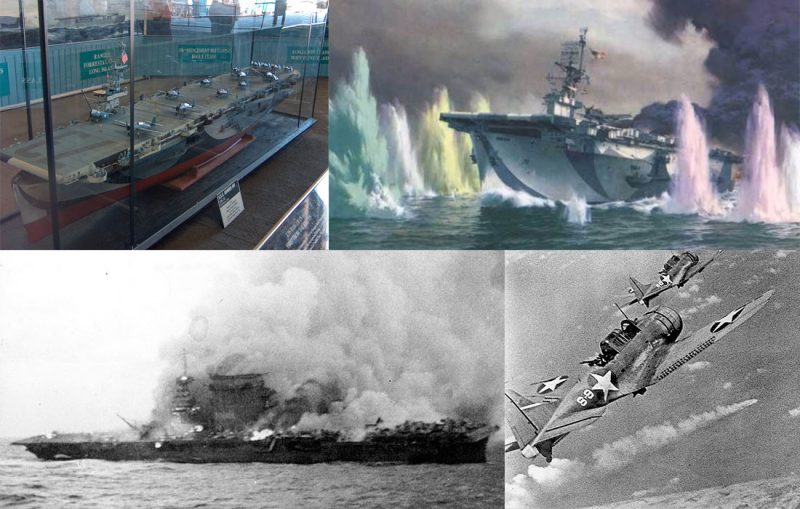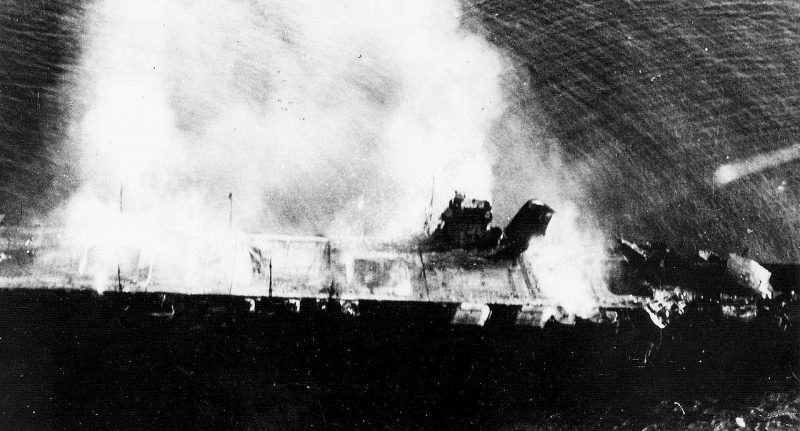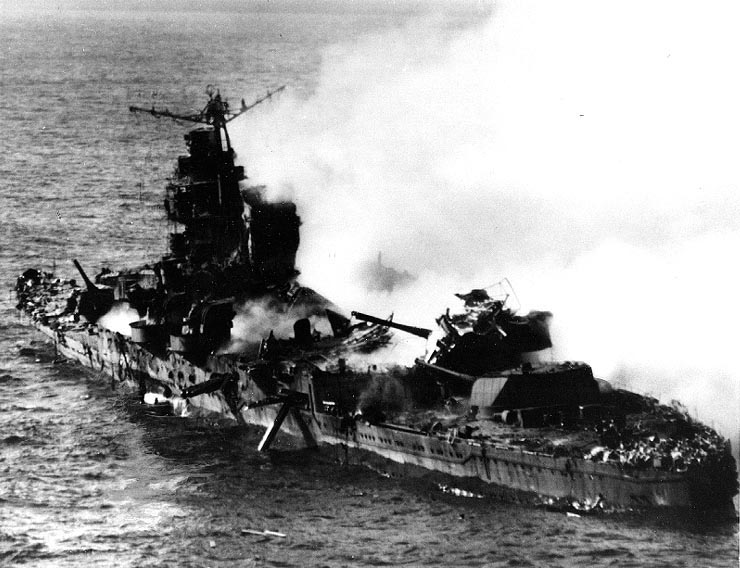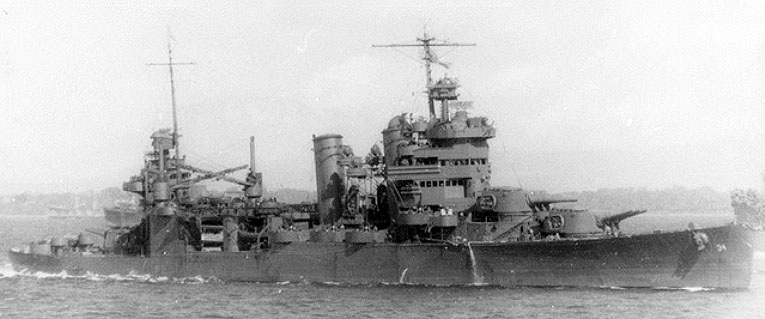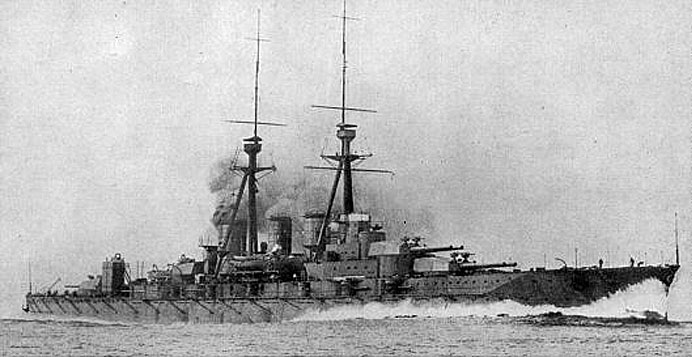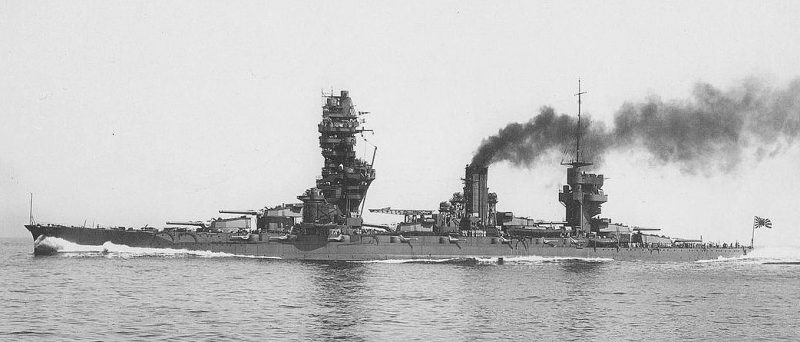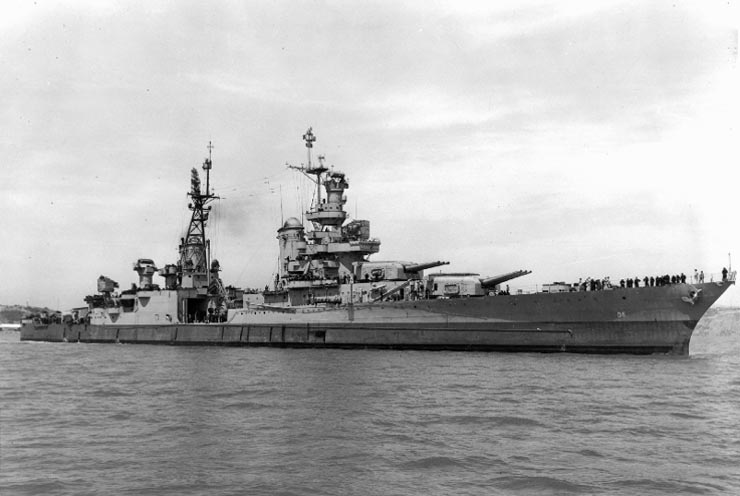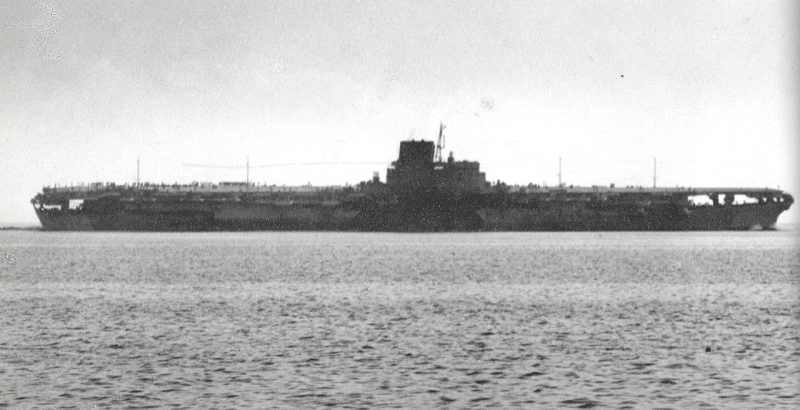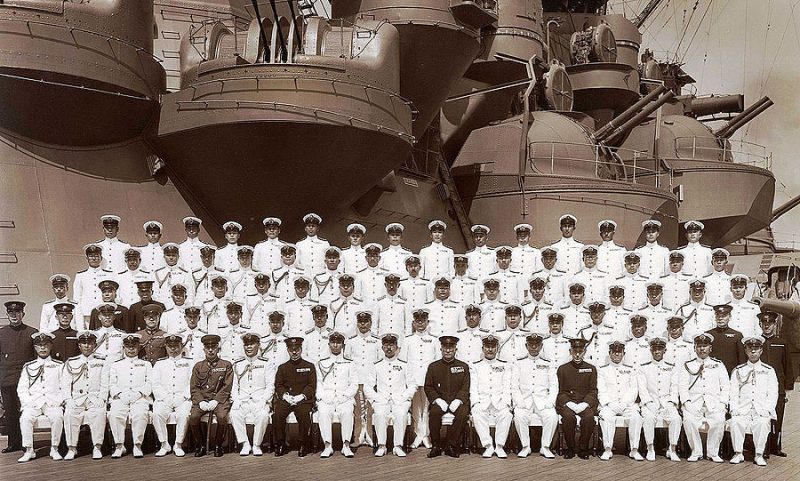Images Used (Clockwise from top left): (1) Model of USS Gambier Bay at USS Midway Museum in San Diego, California (2) Illustration of USS Gambier Bay being shelled by the Japanese ships during WWII (3) American Douglas SBD Dauntless dive bombers from aircraft carrier USS Hornet attacking the Japanese cruiser Mikuma for the third time during the Battle of Midway on June 6, 1942. (4) USS Lexington sinking during the Battle of the Coral Sea
Thousands of warships were deployed around the world during WWII by both Allied and Axis forces. Wikipedia has accumulated an incomplete list of around 1400 major military ships of WWII with displacement of 1,000 tons or more. That list is prepared excluding oilers, landing crafts, troopships. War ships, such as- German U-boats which are known by numbers are not listed individually either. There are 268 more listed warships of WWII with less than 1000 tons displacement. There is also another incomplete list of 142 ships which were sunk by submarines during WWII with death toll surpassing 300. Such was the intensity of the 6 year long global warfare. Many ships sank and their wrecks haven’t been located yet. Titanic sank in 1912 and remained undiscovered on the ocean floor for 73 years until 1985. The ocean doesn’t disclose its secrets easily. Here is story of top 10 Shipwrecks of WWII that are yet to be discovered on the ocean floor.
(10) USS Gambier Bay (CVE-73), Sunk October 25, 1944 during the Battle of Samar, Approximate Location 11°46’0”N, 126°9’0”E:
USS Gambier Bay (CVE-73) was a Casablanca class escort aircraft carrier with a displacement of 7,900 tons. 50 of these carriers were planned and commissioned within two years from November 3, 1942 to July 8, 1944. Casablanca class carriers were one third of the total 151 carriers built in the US during the WWII. These carriers had a length of 512.3 ft (156.1 m), width of 108.1 ft (32.9m), beam of 65.2ft (19.9m), draft (vertical distance between waterline and keel or the bottom of the hull; British word for it is draught) of 22.5 ft (6.9m) and a speed of 20 knots (37kmph). Carriers larger than Casablanca class had extensive armor. Due to limited armors in the form of splinter plating, 5 of these carriers including Gambier Bay were lost to enemy attacks during WWII. The remaining 45 carriers were scrapped after the war by 1960s.
Gambier Bay was called ‘Bonus Ship’ by its shipbuilding company Kaiser due to she was 19th ship delivered in 1943 while the target was 18. She carried 400 troops embarked for Pearl Harbor on February 7, 1944 escorted by destroyer Norman Scott. Off the Marshalls, She flew 84 replacement aircraft to the fleet carrier called Enterprise and then returned to San Diego with aircraft needing repairs. Gambier bay also gave air support to the landings on Saipan in Northern Mariana Islands in Western Pacific ocean in June, 1944. On October 25, The Japanese deployed their entire fleet against the American Naval forces in Leyte Gulf off Philippines but the Japanese Navy was hit hard.
Shortly after this, while US commanders were unaware of the movement of Japanese Center Force during night time, the four Japanese battleships, two light cruisers, 6 heavy cruisers and 11 destroyers had slipped undetected through the coast of Samar. US pilots tried to destabilize the Japanese formation with bombs, torpedoes and strafing and smoke was laid down to break up the enemy formation. However, Gambier Bay was fired on and hit by several Japanese warships. With her only 130mm gun, Gambier Bay fired at one enemy cruiser that was shelling her. The destroyers Heermann and Johnston also made an effort to save her, but all in vain. Her main engine room was flooded and she capsized and sank within an hour. Sharks killed many drifting combatants and 800 survivors were rescued after 2 days. Though US forces suffered significant losses including 3 more warships and many more damages, the Battle of Samar ensured a retreat of a crippled Japanese Navy.
Images Used (From Left): (1) USS Gambier Bay during WWII (2) Japanese heavy cruiser Chikuma and battleship Yamato shelling Gambier Bay during the Battle of Samar on October 25, 1944
(9) USS Lexington (CV-2), Sunk May 8, 1942 during the Battle of the Coral Sea, Approximate Location 15°20’0”S, 155°30’0”E:
USS Lexington (CV-2) was a Lexington-class early aircraft carrier built in the 1920s. She was the lead ship among two of her kind ever built. Lexington had a displacement of 37,000 tons, length of 888 ft (270.7 m), beam of 107 ft 6 in (32.8m), draft of 32 ft 6in (9.9m) and a speed of 33.25 knots (61.58kmph).
Before WWII, the Lexington was used to aid earth quake survivors at Managua in Nicaragua. During WWII, she took part in an attempted diversionary raid on Wake Island in North Pacific on January 27, 1942. She took part in a large raid against Japanese Navy from Gulf of Papua on March 10. Aircraft from Yorktown and Lexington attacked 16 Japanese ships in the area and damaged several vessels. Lexington was then ordered to return to Pearl Harbor.
The combined Allied forces moved into the Coral Sea off the northeast coast of Australia in May, 1942. On May 7, 1942, Japanese fighter aircraft attacked and destroyed oiler USS Neosho and USS Sims, at the same time fighter aircraft from Yorktown and Lexington sank Japanese light carrier Shoho. In the attack, Japanese carrier Shokaku was badly damaged and Zuikaku escaped with minor damages. In a Japanese counterstrike on May 8, Lexington and Yorktown was attacked and Lexington sustained two torpedo hits at around 11:20AM. Soon afterwards, 19 Aichi D3A Japanese dive-bombers attacked Lexington. Though Lexington took down two aircraft, she was hit by two bombs. Within an hour, the leaking aviation fuel tank caused a massive explosion and two hours later another explosion occurred. 216 crewmen of Lexington were killed and 2,735 were rescued. And finally at 19:52, American destroyer USS Phelps was ordered to fire 5 torpedoes to scuttle the critically damaged USS Lexington. US admirals sank her themselves to prevent her from falling into the hands of the Japanese. Both sides suffered significant losses in the battle of the Coral Sea and it is considered as a tactical victory for the Japanese, at the same time, a strategic victory for the Allies.
Images Used (From Left): (1) USS Lexington ordered her crew to abandon ship while it was sinking on May 8, 1942 (2) 3D illustration of the confirmed direct hits sustained by USS Lexington
(8) Japanese aircraft carrier IJN CV Hiryū, Sunk June 5, 1942 during the Battle of Midway, Approximate Location 240-260 miles NW from Midway:
It was the only one ship of her class, a modified Soryu design built for IJN (Imperial Japanese Navy). Japanese word Hiryū means ‘Flying Dragon’. Hiryū had a displacement of 17,600 tons, length of 746 ft 1 in (227.4 m), beam of 73 ft 2 in (22.3m), draft of 25 ft 7in (7.8m) and a speed of 34 knots (63 kmph).
Hiryū took part in Japanese invasion of French Indochina (Now Vietnam, Cambodia and Laos) in mid 1940s, the attack on Pearl Harbor and the Battle of Wake Island. Along with three other fleet carriers, she participated in the Battle of Midway Atoll in North Pacific Ocean in June 1942. Initially, the Japanese forces managed to bombard US forces on the atoll. But on June 4, 1942, the aircraft carriers were attacked by dive-bomber aircraft from USS Enterprise, USS Yorktown, USS Hornet and Midway Atoll. Hiryū became severely crippled and was set on fire. Japanese destroyer Makigumo torpedoed Hiryū on June 5, 1942 at 05:10, as she could not be salvaged. Only 39 men survived as after 4 hours, she sank with bodies of 389 men. Three other Japanese carriers were also sunk during the Battle of Midway, a battle that saw Japan’s first naval defeat since the Battle of Shimonoseki Straits in 1863.
Image Used: The burning and abandoned carrier Hiryū photographed from an aircraft from Japanese carrier Hōshō.
(7) Japanese heavy cruiser Mikuma, Sunk June 6, 1942 during the Battle of Midway, Approximate Location 29°20’0”N, 173°30’0”E:
It was the second among the four Mogami-class Japanese heavy cruisers. Mikuma had a displacement of 13,668 tons, length of 650 ft (198 m), beam of 66 ft (20.2m), draft of 19 ft (5.9m) and a speed of 34.9 knots (64.7 kmph).
Mikuma participated in the occupation of Fench Indochina. At the time of Attack on Pearl Harbor, she took part in the invasion of Malaya (now Malaysia). She also took part in the invasion of British Borneo and covered the landings of Japanese troops at Kuching and Miri in Malaya. She also took part in the Sumatra and Java landings and in the Battle of Sunda Strait in February 1942.
During the Battle of Midway, Mikuma and another Japanese cruiser Mogami collided during a bad maneuver to avoid a submarine attack from USS Tambor on June 5, 1942. Mogami rammed the portside of Mikuma and Mogami’s bow was severly damaged. Mikuma was spilling oil from her portside due to her oil tanks were ruptured. As the morning sky brightened up a bit at 04:12, US submarine Tambor’s Commander John Murphy was certain that Mikuma and Mogami were Japanese ships. But Tambor was unsuccessful in the attack. Eight Boeing B-17 Flying Fortress bombers from the Midway atoll also missed their targets. On June 6, 1942, 31 Douglas SBD Dauntless dive bombers from USS Hornet and USS Enterprise attacked the Japanese Navy and Mikuma was hit by five bombs. Not being able to salvage her, she was scuttled the next day by a Japanese vessel. 240 Japanese combatants were rescued by three Japanese warships but 650 men went down with Mikuma.
Image Used: Japanese heavy cruiser Mikuma sinking on June 6, 1942
(6) USS Astoria (CA-34), Sunk August 9, 1942 during the Battle of Savo Island, Approximate Location 9°12’33”S, 159°52’3”E:
Update: The wreck of the USS Astoria was discovered in early 2015 during a sonar mapping project of Iron Bottom Sound lead by Microsoft co-founder Paul Allen. The wreck lies upright with its bow missing and A turret pointing aft.
USS Astoria was one of the 7 New Orleans class heavy cruisers. She participated in the battle of the Coral Sea and the Battle of Midway. Astoria had a displacement of 9,950 tons, length of 588 ft (179 m), beam of 61 ft 9 in (18.82m), draft of 19 ft 5 in (5.92m) and a speed of 32.7 knots (60.6 kmph).
United States and Japan had good relationship before the WWII. USS Astoria carried the ashes of former Japanese Ambassador to US, late Hiroshi Saito from Maryland to Yokohama between March 3, 1939 and April 17, 1939. It was a US gesture expressing gratitude to Japan for returning the body of late US Ambassador to Japan, Edgar Bancroft, in Japanese cruiser Tama in 1926.
Japanese aircraft launched the devastating attack on Pearl Harbor on the morning of December 7, 1941. Astoria took part in the Battle of Coral Sea in May 1942 and Battle of Midway in June 1942. She was involved with major encounters during the Battle of Savo Island in Solomon Islands on August 8-9, 1942. She provided air cover and shore support. Twelve US and Australian ships were attacked by eight Japanese warships near Savo Island. In a span of 30 minutes, Astoria was hit around 65 times. By the time Astoria’s crew could steer her to safety, it was engulfed with serious fire and was sinking due to leaks. She disappeared beneath the waves at 12 pm on August 9, 1942 with more than half of her crew. The Japanese Navy suffered minor damages than that inflicted to the Allies. With 3 heavy cruisers sunk, the Battle of Savo is often considered to be the worst naval defeat in US history.
Image Used: USS Astoria, photographed on August 8, 1942
(5) Japanese battleship IJN Kongō, Sunk November 21, 1944 at Formosa Strait, Approximate Location 26°9’0”N, 121°23’0”E:
Japanese word Kongō means ‘indestructible’. Four of the Kongō class battleships were built between 1911 and 1915. IJN Kongō was the first of the class and participated in both the world wars. She had a displacement of 37,187 tons, length of 728 ft 4 in (222 m), beam of 101 ft 8 in (31m), draft of 31 ft 10 in (9.7m) and a speed of 30 knots (56 kmph). She was designed by British naval engineer George Thurston and was built in Cumbria, England in 1913.
Kongō was assigned to patrol off the Chinese coast during WWI. She was refurbished massively before WWII. She took part in a great number of actions in the Pacific Ocean theater of WWII. She covered the Japanese Army landings in Malaya and Dutch East Indies (now Indonesia) in 1942. Kongō then took part in the Battle of Midway and Guadalcanal Campaign. Throughout 1943, she was deployed several times to defend Japanese island bases across the Pacific which were under air raids from US aircraft carriers. Kongō participated in the Battle of Philippine Sea and the Battle of Leyte Gulf in 1944 and sank US vessels at Leyte Gulf. While passing through the Formosa Strait between mainland China and Taiwan on November 21, 1944, she was torpedoed and sunk by USS Sealion, a balao class US submarine. She was the only Japanese battleship sunk by a submarine in WWII and the last battleship in history that was sunk by a submarine.
Image Used: IJN Kongō in her pre-1927 configuration
(4) Japanese battleship IJN Fusō, Sunk October 25, 1944 at Surigao Strait, Approximate Location 9°50’0”N, 125°20’0”E:
IJN Fusō was the lead ship among two Fusō class dreadnought battleships. She was commissioned in 1915. She had a displacement of 29,800 tons, length of 673 ft (205.13 m), beam of 94 ft (28.65 m), draft of 28 ft 6 in (8.69m) and a speed of 23 knots (43 kmph).
Fusō patrolled off the Chinese coast during WWI and in 1923, assisted the survivors of Great Kantō earthquake which had a magnitude of 7.9. She was modernized twice before WWII. But despite modifications, Japanese Navy found Fusō class ships to be too lightly armored and too slow to be of any important use. Other Japanese warships outclassed Fusō and she mostly participated in auxiliary roles during the war. She was strategically kept in the inland sea as a backup force. During the Battle of Surigao Strait in southern Philippines, she was hit by 2-3 American torpedoes on the starboard side and capsized slowly to starboard in the early hours of October 25, 1944. The torpedo attacks were launched from US destroyers and torpedo hits caused an oil fire too. Fusō sank within 40 minutes and among the few dozen of the crew member who survived the fire, only 10 could return to Japan.
Image Used: Fusō on May 10, 1933, with Pagoda shaped mast after a renovation
(3) USS Indianapolis (CA-35), Sunk July 30, 1945 while going from Guam to Philippines, Approximate Location 12°2’0”N, 134°48’0”E:
Indianapolis was an American Portland class heavy cruiser and was commissioned in 1932. She had a displacement of 10,000 tons, length of 610 ft (190 m), beam of 66 ft (20 m), draft of 27 ft 4 in (5.28m) and a speed of 32.7 knots (60.6 kmph).
Indianapolis delivered the world’s first atom bomb to the island of Tinian in Mariana Islands in the North Pacific on July 26, 1945. She was then ordered to join USS Idaho at Leyte Gulf in the Philippines to get ready for the invasion of Japan. She left Guam without any escorts and on July 30, 1945, Japanese cruiser submarine I-58 torpedoed her and she sank in just 12 minutes. Among the 1,196 crewmen aboard USS Indianapolis, around 300 went down with the ship. After facing dehydration, saltwater poisoning, Hypothermia and shark attacks, only 317 out of the remaining 900 crew survived.
Image Used: USS Indianapolis off Mare Island alongside California on July 10, 1945
(2) Japanese aircraft carrier IJN Shinano, Sunk November 29, 1944, while going from Yokosuka to Kure, Approximate Location 32°0’0”N, 137°0’0”E:
Shinano was the third of the three Yamato class battleships, the largest and most massively armed battleships of the world up to that time. The battleship was converted into a super aircraft carrier during the hull was partially completed following a disastrous Japanese losses of four carriers during the Battle of Midway in 1942. She was completed for trials in 1944. Shinano had a displacement of 65,800 tons, length of 872 ft 2 in (265.8 m), beam of 119 ft 1in (36.3 m), draft of 33 ft 10 in (10.3m) and a speed of 27 knots (50 kmph).
She was en route to Kure Naval Base for the completion of her construction and was also carrying a cargo of 50 Yokosuka MXY7 Ohka rocket propelled flying bombs. Shinano had serious design flaws, an inexperienced crew, inadequate pumps and fire control system and had no carrier aircraft on board. On November 29, 1944, she was sunk just 10 days after being commissioned. American submarine USS Archerfish (SS-311) fired just 4 torpedoes at Shinano and it was enough to sink her as she had virtually no pumps or watertight doors in the underwater portion. There were 2515 men on board and she sank taking 1,435 men to their deaths. Shinano’s 1080 survivors were isolated for months in an island by Japanese authorities to suppress the news of the carrier’s loss.
Image Used: Shinano in Tokyo Bay during her trials
(1) Japanese battleship IJN Musashi, Sunk October 24, 1944, at Sibuyan Sea, Approximate Location 12°50’0”N, 122°35’0”E or 13°07’0”N, 122°32’0”E:
UPDATE 3-3-2015, The Musashi has been found and will be taken off this list, 9 more wrecks to find!
IJN Musashi was another of the three Yamato class super battleships. Mushahi and her sister ship Yamato were the most powerfully armed and the heaviest battleships of the world up to that time. Musashi was commissioned in 1942. She had a displacement of 72,800 tons, length of 862 ft 10 in (263 m), beam of 121 ft 1 in (36.9 m), draft of 35 ft 8 in (10.86m) and a speed of 27.46 knots (50.86 kmph).
It was named after a Japanese province. She was used to carry combatants and war equipment between Japan and several occupied islands in 1944. While carrying Japanese Army from Yokosuka to Palau Islands in Micronesia, American Gato class submarine USS Tunny fired 6 torpedoes at her on March 29, 1944. First five missed Musashi, but the sixth one blew a hole near her bow. The hole was 19ft in diameter and killed 7 of her crew. After temporary repairs, she had to sail for Japan for thorough repair. She took part in the Battle of the Philippine Sea in June, 1944.
On October 22, 1944, Musashi, along with her sister ship Yamato and several other Japanese ships left Brunei Bay to enter Leyte Gulf to destroy US forces there. While transiting the Sibuyan Sea in the Philippines on October 24, 1944, the Japanese fleet was spotted by a US reconnaissance aircraft from fleet carrier USS Intrepid. Within couple of hours, Musashi was attacked by eight ‘Curtiss SB2C Helldiver’ dive bombers from Intrepid. More attacks followed and she took total 17 bombs and 20 torpedoes in a massive American airstrike. Within four hours she capsized and sank in 4,430 ft. 1,376 of Musashi’s 2,399 men were rescued.
Image Used: Japanese Emperor Hirohito with officers of battleship Musashi on board Musashi on June 24, 1943
